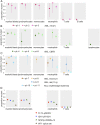Differentiation of leukemic blasts is not completely blocked in acute myeloid leukemia
- PMID: 31754026
- PMCID: PMC6900505
- DOI: 10.1073/pnas.1904091116
Differentiation of leukemic blasts is not completely blocked in acute myeloid leukemia
Abstract
Hematopoiesis, the formation of blood cells, involves the hierarchical differentiation of immature blast cells into mature, functional cell types and lineages of the immune system. Hematopoietic stem cells precisely regulate self-renewal versus differentiation to balance the production of blood cells and maintenance of the stem cell pool. The canonical view of acute myeloid leukemia (AML) is that it results from a combination of molecular events in a hematopoietic stem cell that block differentiation and drive proliferation. These events result in the accumulation of primitive hematopoietic blast cells in the blood and bone marrow. We used mathematical modeling to determine the impact of varying differentiation rates on myeloblastic accumulation. Our model shows that, instead of the commonly held belief that AML results from a complete block of differentiation of the hematopoietic stem cell, even a slight skewing of the fraction of cells that differentiate would produce an accumulation of blasts. We confirmed this model by interphase fluorescent in situ hybridization (FISH) and sequencing of purified cell populations from patients with AML, which showed that different leukemia-causing molecular abnormalities typically thought to block differentiation were consistently present in mature myeloid cells such as neutrophils and monocytes at similar levels to those in immature myeloid cells. These findings suggest reduced or skewed, rather than blocked, differentiation is responsible for the development of AML. Approaches that restore normal regulation of hematopoiesis could be effective treatment strategies.
Keywords: AML; differentiation block; mathematical model.
Conflict of interest statement
Competing interest statement: B.J.D. potential competing interests: The Scientific Advisory Board (SAB): Aileron Therapeutics, ALLCRON, Cepheid, Vivid Biosciences, Celgene, RUNX1 Research Program, EnLiven Therapeutics, Gilead Sciences (inactive), Baxalta (inactive), and Monojul (inactive); SAB & Stock: Aptose Biosciences, Blueprint Medicines, Beta Cat, Third Coast Therapeutics, GRAIL (inactive), and CTI BioPharma (inactive); Scientific Founder: MolecularMD (inactive, acquired by ICON); Board of Directors & Stock: Amgen; Board of Directors: Burroughs Wellcome Fund, CureOne; Joint Steering Committee: Beat AML LLS; Founder: VP Therapeutics; Clinical Trial Funding: Novartis, Bristol-Myers Squibb, Pfizer; Royalties from Patent 6958335 (Novartis exclusive license) and Oregon Health & Science University (OHSU), and Dana-Farber Cancer Institute (one Merck exclusive license).
Figures




References
Publication types
MeSH terms
Substances
Grants and funding
LinkOut - more resources
Full Text Sources
Other Literature Sources
Medical
Research Materials

